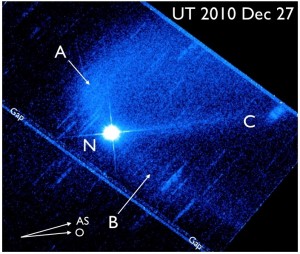By David Jewitt
Caption: N = principal nucleus, a 120-meter diameter body. AA and BB = cross arms of the “X” structure, though to consist of larger blocks released from the nucleus. C = objects embedded in the “X” arms and detected on more than one date. These are secondary sources of dust for the tail. E = faint extension above the main tail, slightly blended with a smeared, background galaxy. F = filaments of dust released from discrete sources within the “X”. S = Star and background galaxy trails, imperfectly removed from the data.
P/2010 A2 has the orbit of an asteroid but a physical appearance more like a comet. It is one of the “active Asteroids” (or “main-belt comets”) discovered in the last few years. This object was observed at high resolution using the Hubble Space Telescope from January to May 2010, showing subtle changes associated with changes in the viewing geometry. The object shows a point-like nucleus at the leading end that is about 120 meters in diameter. Most likely, this object was struck by a much smaller asteroid, probably just a few meters across, in early 2009. The dispersing remnant, seen in the picture above, includes ribbons and sheets of debris that are pushed away from the sun by the pressure of sunlight. From models of this radiation pressure, we find that the dust particles in the tail range from centimeter size near the nucleus, N, to millimeter size at the far right edge of the picture.
The scientific significance of this object is that it opens the door to real-time study of asteroid disruptions. In the past, we could observe the ancient remnants of past collisions, but had to resort to elaborate models in the context of modern-day collisional evolution of the belt. Collisions are a primary mechanism of asteroid destruction and an important source of dust.
A paper describing the discovery and HST observations is linked here (1 Mb pdf). Pre-discovery observations are linked here (2.8Mb pdf). There is also a stand-alone P/2010 A2 web site.
 Soon after P/2010 A2, a second example of likely impact ejection from an asteroid, this time the 100 times larger body (596) Scheila, was discovered by Steve Larson.
Soon after P/2010 A2, a second example of likely impact ejection from an asteroid, this time the 100 times larger body (596) Scheila, was discovered by Steve Larson.

